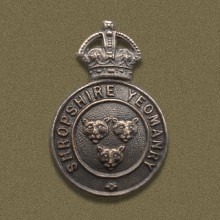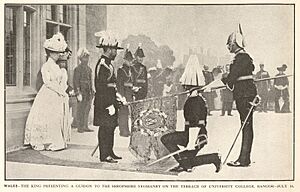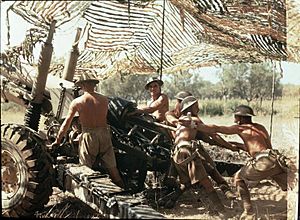Shropshire Yeomanry facts for kids
Quick facts for kids Shropshire Yeomanry |
|
|---|---|

Badge of the Shropshire Yeomanry
|
|
| Active | 1795–1969 |
| Country | |
| Branch | |
| Type | Cavalry |
| Role | Yeomanry |
| Part of | Royal Armoured Corps |
| Engagements | Second Boer War First World War |
| Battle honours | See battle honours below |
| Commanders | |
| Honorary Colonel | Colonel Francis S. Acton, VR |
| Insignia | |
| Identification symbol |
Shrop Yeo |
The Shropshire Yeomanry was a special kind of army unit in the British Army. It was first formed way back in 1795. This unit served as cavalry (soldiers on horseback) and later as infantry (soldiers on foot) during the First World War. In the Second World War, it became an artillery unit, using big guns.
After 1969, the Shropshire Yeomanry joined with other units. Today, it is part of the Royal Yeomanry, continuing its long history.
Contents
- A Look at the Shropshire Yeomanry's History
- Regimental Museum
- Victoria Cross Hero
- Battle Honours
- Uniforms Through the Years
- See also
A Look at the Shropshire Yeomanry's History
How the Shropshire Yeomanry Started
The Shropshire Yeomanry began during the French Revolutionary Wars in 1795. At that time, many volunteer cavalry groups were created across Britain. In Shropshire, one of these groups was the Wellington Troop.
Over time, these smaller groups joined together. By 1815, they formed three larger units: the Shrewsbury Yeomanry Cavalry, the South Shropshire Yeomanry Cavalry, and the North Shropshire Yeomanry Cavalry. In 1872, all three of these units combined to become one single Shropshire Yeomanry unit.
In 1821, some Shropshire Yeomanry troops were present during the Cinderloo Uprising. This was a protest by 3,000 coal miners in what is now Telford. They were upset about their wages being cut. There were clashes between the Yeomanry and the workers.
Serving in the Second Boer War
The Yeomanry units were originally meant to defend Britain at home. However, during the Second Boer War (1899-1902) in South Africa, the British Army needed more soldiers. So, in 1899, the government asked volunteer forces like the Yeomanry to help.
The Shropshire Yeomanry sent about 115 men to join the Imperial Yeomanry. These soldiers were trained to fight on horseback but also on foot, like Mounted infantry. This idea worked well. In 1901, the Shropshire Yeomanry officially became the Shropshire Imperial Yeomanry. Later, in 1908, when it joined the Territorial Force, the word 'Imperial' was dropped. The unit's main office was in Shrewsbury.
Fighting in the First World War
When the First World War started in August 1914, many members of the Territorial Force volunteered to serve overseas. Because of this, Yeomanry units were split into different groups:
- 1st Line units were ready to go overseas.
- 2nd Line units stayed in Britain for home defense.
- 3rd Line units were reserves, training new soldiers to replace those fighting.
The 1/1st Shropshire Yeomanry in Action
The 1/1st Shropshire Yeomanry was sent to East Anglia in September 1914. In November 1915, they stopped fighting on horseback and became foot soldiers.
In March 1916, the regiment moved to Egypt. There, in March 1917, the 1/1st Shropshire Yeomanry joined with another unit, the 1/1st Cheshire Yeomanry. Together, they formed the 10th (Shropshire and Cheshire Yeomanry) Battalion, King's Shropshire Light Infantry.
This new battalion became part of the 74th (Yeomanry) Division. They fought in the invasion of Palestine in 1917 and 1918. They took part in important battles like the Second Battle of Gaza and the Third Battle of Gaza. They also helped capture Beersheba and Jerusalem.
In April 1918, the division moved to France. There, they learned about trench warfare and gas defense for the Western Front. From September 1918, they were part of the Hundred Days Offensive. This included battles like the Second Battle of the Somme. By the end of the war, they were near Tournai, Belgium. The unit was officially disbanded in July 1919.
The 2/1st Shropshire Yeomanry at Home
The 2nd Line regiment was formed in 1914. It stayed in Britain, mainly in the Newcastle area. In 1916, many Yeomanry units, including this one, changed from cavalry to cyclists. They moved to East Anglia and then to the Morpeth, Northumberland area.
In early 1918, the unit moved to Ireland, staying at The Curragh. They remained there until the war ended.
The 3/1st Shropshire Yeomanry as a Reserve
The 3rd Line regiment was formed in 1914. Its job was to train new soldiers. In 1916, it also became a dismounted unit. The regiment was disbanded in early 1917. Its soldiers either joined the 2nd Line unit or another infantry battalion.
Between the World Wars
After the First World War, leaders decided that cavalry (soldiers on horses) were no longer as important. Many Yeomanry regiments changed their roles. The Shropshire Yeomanry was one of the few that stayed as a horsed cavalry unit for a while.
Serving in the Second World War
The 75th (Shropshire Yeomanry) Medium Regiment, RA
In September 1939, the Shropshire Yeomanry was still a horsed cavalry unit. But in 1940, they gave up their horses and became an artillery regiment. This meant they would use large guns. They were renamed the 75th Medium Regiment, Royal Artillery.
In 1943, the regiment traveled to Egypt and then to Sicily. They used 4.5-inch and 5.5-inch howitzers (types of artillery guns). They fought throughout the Italian campaign. They supported both the 5th Army and the 8th Army. They were involved in many famous battles, including the third battle of Monte Cassino. They also helped capture Florence and Forlì.
The regiment continued fighting in the Apennines mountains and in the final attacks of the 8th Army in 1945. When the war ended, they were in Italy, facing the Yugoslav army.
The 76th (Shropshire Yeomanry) Medium Regiment, RA
Another part of the Shropshire Yeomanry also became an artillery unit in 1940. This was the 76th Medium Regiment. They trained a lot and were first equipped with 60-pounder guns, later replaced by 6-inch and 5.5-inch howitzers.
In August 1942, they sailed to the Suez Area. In 1943, they moved through the Middle East, including Baghdad and Syria. They eventually landed in Taranto, Italy, in December 1943.
They joined the 8th Army and took over from their sister-regiment. They fought in the battles of Monte Cassino in February and May 1944. They also helped break through the Hitler Line. The regiment supported the 6th South African Armoured Division and the 6th Armoured Division in their advance beyond Rome, including the fight for Florence.
In April 1945, they joined the final attack with the 8th Army. After Germany surrendered on May 2, 1945, the regiment continued to serve on the road to Austria. Like the 75th Regiment, they were near Trieste when the war ended.
After the Second World War
Since 1947, the Shropshire Yeomanry has been part of the Royal Armoured Corps. This means they have used tanks, armored cars, and other military vehicles.
In 1967, the Shropshire Royal Horse Artillery joined with the Shropshire Yeomanry. However, in 1969, the regiment was officially disbanded. It was replaced by other units, including No. 4 Squadron, 35 (South Midlands) Signal Regiment.
Later, in 1971, the Shropshire Yeomanry Squadron was formed as part of the Mercian Yeomanry. This unit focused on home defense.
The Shropshire Yeomanry Today
In 1995, the Shropshire Yeomanry celebrated its 200th anniversary! Today, it continues as D (Shropshire Yeomanry) Squadron of the Royal Yeomanry. This unit is based in Dawley Bank, Telford. They are now a 'light cavalry' unit, using special vehicles like the Land Rover RWMIK.
Regimental Museum
You can learn more about the Shropshire Yeomanry at the Shropshire Regimental Museum. It's located at Shrewsbury Castle and also has collections from the King's Shropshire Light Infantry.
Victoria Cross Hero
The Victoria Cross is the highest award for bravery in the face of the enemy for British and Commonwealth soldiers. Only one Victoria Cross was given to a member of the Shropshire regiment during the First World War. This award went to Private Harold Whitfield. He earned it on March 10, 1918, for his bravery during the Battle of Tell 'Asur in Palestine.
Battle Honours
The Shropshire Yeomanry earned many special "battle honours" for their brave actions. These honours are like awards that show where the regiment fought with courage. The ones in bold are proudly displayed on the regiment's flags.
| Second Boer War | South Africa 1900–02 | |
| First World War | Hindenburg Line, Épehy, Pursuit to Mons, France and Flanders 1918, Egypt 1916–17, Gaza, Jerusalem, Jericho, Tell 'Asur, Palestine 1917–18 | |
| Second World War | The Royal Artillery fought in almost every battle. In 1833, King William IV gave them the motto Ubique (meaning "everywhere") instead of individual battle honours.
Honorary Distinction: Badge of the Royal Regiment of Artillery with the years "1943–45" and two scrolls: "Sicily" and "Italy" |
Uniforms Through the Years
In 1872, when the Shropshire Yeomanry units combined, they chose a dark-blue uniform with red parts, similar to heavy cavalry. They also wore a silver and bronze helmet with a spike. For parades, they had a white and scarlet feather plume. Even when many other units simplified their uniforms, the Shropshire Yeomanry kept their fancy blue and red uniform for special events. Before World War I, they wore khaki (a brownish-green color) cavalry uniforms for most duties. After they became an artillery unit in 1940, they wore the standard battle dress.
See also
- Imperial Yeomanry
- Yeomanry
- British yeomanry during the First World War
- List of British Army Yeomanry Regiments converted to Royal Artillery




